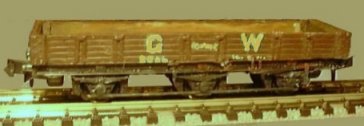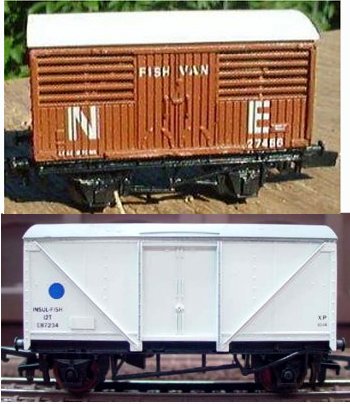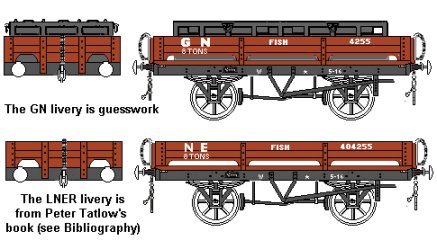Fish traffic required special handling as it was vital that the fish reached the shops fresh and fish stock was regularly attached to main-line passenger trains as well as being run in block express goods trains. Originally open wagons were widely used for fish but by the early twentieth century everyone had switched to building covered vans for this work. The open wagons remained in use for fish traffic with several companies up to about the time of the First World War.
All fish carrying stock, both open wagons and vans, were usually equipped with vacuum brakes so they could be attached to passenger trains for rapid transit. To allow high speed running most fish stock used longer than normal wheelbase chassis, the GWR originally used a long wheelbase open wagon with a small hut like structure in the middle but these were phased out by about the 1920's. Later versions, built on six wheeled chassis from redundant passenger coaches, survived (I believe) into the late 1920's, possibly the early 1930's. Originally painted grey with white wagon type marking (including the G and W repeated on the ends) they changed to brown following the First World War.
GWR Fish Truck

Most of the UK fishing fleets docked on the Eastern coasts served by the LNER, who claimed that 70% of all fish eaten was landed at ports served by their company. The principal fishing ports were Grimsby, Hull, Aberdeen and Fleetwood whilst Lowestoft, Milford Haven and Leith also saw regular train loads of fish. Herring was fished all year round but there was a 'season' from about June to about September when vast numbers were caught. Herring became a major industry in Peterhead and Fraserborough in Scotland and Yarmouth and Lowestoft in East Anglia. Most of the herring catch was processed locally and as much of the produce was exported there was less involvement with the railways but even so entire trains of herring were sent through the system.
The coming of the railway allowed Grimsby to become the worlds largest fishing port, besides which its docks handled a lot of imported timber (mainly from the Baltic) and exports of coal.
At the port the fish was landed into covered transfer sheds on the quay where the buying and selling took place. The goods lines used for fish were run down to the docks where the fish vans and wagons would be lined up, sometimes on as many as three sidings abreast. The fish in baskets, barrels or more usually light wooden boxes was carried directly from the transfer sheds to the waiting fish vans. As the vans were often on several sidings abreast light wooden bridges were provided to allow the men to load the fish quickly into the railway stock.
Fish cargo was slightly unusual as carriage was charged for on a weight basis, often as little as three tons being loaded into a four wheel van. Had the railways charged on a per van basis overloading could have resulted in claims for damaged goods at the receiving end. The fish trains were pulled by fast express loco's, the LNER regularly used their A4 Pacific's for the run down to London and double heading was quite common with a 4-6-0 and perhaps a 4-4-0 tender engines heading a rake of perhaps twenty assorted fish vans.
The LNER and its pre-grouping constituents had the largest numbers of purpose built rolling stock for fish traffic, including both four wheeled and bogie vehicles. Graham Farish offer a four wheeled ex-Great Northern Railway van in LNER livery (a few of these survived into early BR days) and the Peco fifteen foot wheelbase 'parcels van' is actually based on a 1940's LNER designed fish van (they were later converted for use as parcels stock by BR). The Peco model uses their standard long wheelbase chassis however a more accurate model of this van has now been introduced by Parkside Dundas. The GWR also handled a substantial quantity of fish traffic and this company had purpose built stock as well. The P D Marsh Mink C kit can be modified to represent the GWR 'Bloater' fish van. The photos show the Graham Farish N Gauge van and the Dapol OO scale long wheelbase van.
Fig ___ Fish Vans

Compared to the LNER the LMS and the SR had only a limited amount of fish traffic, this was still enough to justify the use of purpose built stock however. They inherited purpose built fish vans from the pre-grouping companies, the LMS built some fish vans but I do not know of any SR fish vans being built after the 1923 grouping.
As mentioned in the section on Unit Loads - Early container types the Midland Railway and Great Central Railway both tried a container service for live fish. The GCR used standard wagons to carry these but the Midland Railway and Great Northern Railway (and possibly others) built special wagons for the tanks. The GN wagon lasted in use into the later 1920's (possibly the early 30's) and is an easy option using a Peco chassis kit with a floor of 10 thou card. If it is to run unloaded bore a hole in the chassis and fill with two crushed air gun pellets. The sides are 2mm wide strips of 20 thou sitting on short lengths of 20x20 thou strip, the strapping is from 10x40 thou strip at the ends and 10x20 thou in the centre. The end posts are 20x20 thou strip and the vacuum pipes are bent up from guitar wire. These remained in service into the late 1920's although I am not sure if the fish in the tanks were still live at that stage, they may have been packed in salt or crushed ice. These were dual braked, the W and star on the chassis marking the release chains for the Westinghouse (air) brake and the vacuum brake.
GNR Fish Tank Truck in GN and LNER livery

The GWR used what appear to be identical containers for frozen fish in the 1930's, by which time standard container flat wagons were available to carry these. The GWR boxes operated from Milford Haven and possibly other ports.
By the time of the second world war fish traffic was already suffering from road competition but most fish travelled in train-loads by rail and some of the hauls were very long (Aberdeen to London was a distance of some 540 miles). In the early 1950's there were some seven thousand wagon loads a week plus smaller consignment going to outlying stations on the network. In spite of this the Beeching Report declared fish traffic uneconomic and in 1964 BR stopped carrying fish entirely. Some of the more modern fish vans were then transferred to parcels duties.
